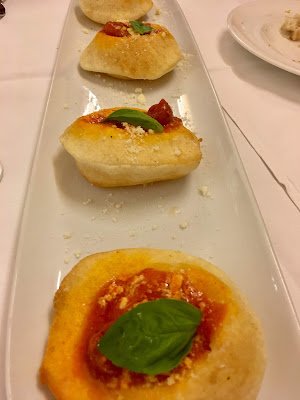Mastering pizza fritta
The city of Napoli has offered the world many gastronomical triumphs that the term “Cucina Napoletana” refers not only to the city of Naples proper, but of the entire region of Campania itself. The UNESCO protected art of pizza-making is what Neapolitans are most known for, but truth be told, that’s just the tip of the culinary iceberg that this ancient metropolis has to offer.
With Stellina's Chef Matteo Venini andMaestro Pizzaiolo Antonio Fusco
One of the lesser known edible delights born out of Napoli is Pizza Fritta, or “Fried Pizza,” a tradition that I’ve loved since childhood. For many Italian-Americans, pizza fritta refers to fried pizza dough that is served sweet – topped with powdered sugar. It’s served at carnivals, street festivals, or often after making pizza at home. Sometimes the term is used to refer to fried zeppole, also believed to be the original pizze fritte, which are small pieces of dough, fried and topped with powdered sugar, or at holiday time stuffed with anchovies, fried, and served as an appetizer during holidays.
Then there’s what the Napoletani refer to as pizza fritta…fried pizza dough which is filled with a variety of savory fillings from classic, high-quality mozzarella and tomatoes to smoked provola, meats, and more. The first time I ever heard about this type of pizza being described was by Sophia Loren, so even though pizze fritte are a quintessential street food – for me they will always conjure up glamorous images of all that is good in Italian food.
Fast forward a few decades and I attended one of Don Antonio Starita’s pizza-making classes at the Pizza University and Culinary Arts Center and got to taste his pizza fritta. Once you experience something perfectly made by a maestro, the bar of standards on that particular recipe is forever locked in at the top – and there’s no where to go but down.
Luckily, my second pizza fritta was served to me by Maestro Pizzaiolo Enzo Coccia -while taking his The Culture of Neapolitan Pizza Cooked in a Wood 🔥Oven pizzaiolo certification class, also at the Pizza University.
The Maestro, who has written books and teaches university courses on pizza-making at the University of Naples, told me that the tradition of frying pizzas was born in the friggitorie, or fry shops, centuries ago. The affordable street food edged it’s way not only into the heart of locals, but in the hearts of prominent literary figures such as Alexander Dumas and historians as well.
This February my friend, maestro pizzaiolo, and Naples-native Antonio Fusco joined the "From Capri with Love" tour with Ristorante D'Amore's owner Marco D'Amore and Executive Chef Pasquale Rinaldo here in the United States. Antonio's task was to create Montanare and Pizze Fritte for the events we held at the James Beard House in NYC and at Stellina Pizzeria in DC.
I had already met Antonio at Ristorante del Pino (a food emporium like none I've ever seen) in Naples where he heads the pizza department prior to his arrival in the states, so I knew I was in for a treat.
Antonio is truly committed to his art and stops short of nothing to deliver the best results. His fried pizzas are light and airy - with the perfect combination of fillings that leave you begging for more.
A few of Antonio's specialties that he prepared
in the US were:
Montanara fritta con pomodoro San Marzano e provolone del Monaco
Classic, Amalfi-Coast Style Flash-Fried and Baked Pizza with San Marzano Tomatoes and Provolone del Monaco
Pizza fritta di Antonio Fusco ricotta romana Provola affumicata pomodoro e pepe nero,
Antonio Fusco’s Fried Pizza with Roman Ricotta, Smoked Provolone, tomatoes, and Black Pepper
Montanara fritta a quattro mani con carbonara agli agrumi,
Pizzaiolo Antonio Fusco’s Flash-Fried and Baked Pizza with Chef Pasquale Rinaldo’s Citrus Infused Carbonara
Now, thanks to Antonio's fantastic teaching skills, I can recreate the perfect pizza fritta whenever I want to. Like all maestros, Antonio is so dedicated to his craft that through watching him work you learn not only about the pizza he is creating, but of the culture, and pizza that created it. If everyone took as much pride in their work as Antonio did, the world would be a much better place. Try your hand at Antonio Fusco's signature dish with this recipe:
INGREDIENTS FOR 2.2 POUNDS DOUGH:
2.2 pounds flour OO
27 grams salt
3 grams fresh Brewer’s Yeast
630 grams water, at room temperature, divided
Preparation:
Combine all of the ingredients (reserving 1 cup of water) in a large bowl, until dough is formed.
Knead for 6-7 minutes and then work in the rest of the water until it is all incorporated and dough is smooth.
Cover with a clean kitchen cloth and allow the dough to rest for an hour.
After the dough has risen, divide it into even size balls of your preference – I make 13/14 balls that weigh 120 grams each and place a few inches a part on a clean surface lightly dusted with flour.
Let the dough balls rise at room temperature for 30 minutes.
Lightly flour a large dough proofing box or 1arge baking sheets and place the dough balls
3-4 inches apart in each one. Cover loosely with clean kitchen towels and refrigerate for 24 hours.
Remove the dough 45 minutes prior to use. This video shows how to shape and fry the pizzas:
Shape dough into evenly sized (120 gram each) balls.
Let the dough rest by preparing your filling.
Antonio says that fresh Roman ricotta, fresh smoked provola cheese, peeled San Marzano tomatoes and grated cheese is the most traditional combination of fillings - often with the addition of small bits of pork.
Next flatten out the balls of dough (see video) and fill with a few tablespoons of filling.
It is important to then roll the dough up over the filling and see it well so that non of the filling comes out.
Bring oil to approximately 375F degrees. Add the pizzas - one or a few at a time depending on the size of your fryer - do not overcrowd. With a metal spatula, carefully turn pizzas often to ensure even cooking - and lightly splatter oil over the tops to brown.
Remove from oil and blot with absorbent kitchen paper before serving.
IN ITALIANO
La città di Napoli ha regalato al mondo molti trionfi gastronomici che il termine "Cucina Napoletana" si riferisce non solo alla cucina della città di Napoli propria, ma dell'intera regione della Campania stessa.
L'arte della pizza protetta dall'UNESCO è ciò per cui i napoletani sono più noti, ma a dire la verità questa antica metropoli ha tantissimo da offrire.
Una delle delizie di gola napoletane meno conosciute è la Pizza Fritta, una tradizione che ho amato fin dall'infanzia. Per molti italo-americani, la pizza fritta si riferisce ad un impasto per pizza fritto che viene servito dolce - condito con zucchero a velo. Viene servito in carnevali, feste di strada o spesso dopo aver fatto la pizza a casa. A volte il termine è usato per indicare le zeppole fritte, che sono piccoli pezzi di pasta, fritte e condite con zucchero a velo, o durante le vacanze ripiene di acciughe, fritte e servite come antipasto.
Poi c'è quello che i Napoletani chiamano pizza fritta ... con l'impasto fritto che viene riempita con una varietà di ripieni salati dalla classica mozzarella e pomodori di alta qualità alla provola affumicata, alle carni e altro ancora. La prima volta che ho mai sentito parlare di questo tipo di pizza descritta da Sophia Loren, quindi anche se la pizza fritta è un cibo di strada per eccellenza - per me evocherà sempre immagini glamour di tutto ciò che è buono nel cibo italiano.
L'anno scorso ho partecipato ad una delle lezioni di pizza di Don Antonio Starita alla Pizza University e al Culinary Arts Center e ho avuto modo di assaggiare la sua pizza fritta. Una volta che hai sperimentato qualcosa di perfettamente fatto da un maestro, la barra degli standard su quella particolare ricetta è per sempre bloccata in alto - e non c'è altro posto dove andare se non verso il basso.
Fortunatamente, la mia seconda fritta di pizza mi è stata servita dal Maestro Pizzaiolo Enzo Coccia, mentre frequentavo il corso di Cultura della Pizza Napoletana Cotta in un forno a legna di pizzaiolo, sempre alla Pizza University. Il Maestro, che ha scritto libri ed insegna corsi universitari sulla pizza all'Università di Napoli, mi ha detto che la tradizione di friggere le pizze è nata nei friggitorie napoletane, secoli fa. Il cibo di strada a prezzi accessibili si è fatto strada non solo nel cuore della gente del posto, ma anche nel cuore di importanti personaggi letterari come Alexander Dumas e storici.
A febbraio il mio amico, maestro pizzaiolo napoletano, Antonio Fusco, è venuto qui negli stati uniti per partecipare nel tour "From Capri with Love" con il proprietario del ristorante D'Amore, Marco D'Amore e lo chef esecutivo Pasquale Rinaldo.
Il compito di Antonio era quello di creare Montanare e Pizze Fritte per gli eventi che abbiamo tenuto alla James Beard House a New York e alla Stellina Pizzeria a DC.
Avevo già incontrato Antonio al Ristorante del Pino a Napoli prima del suo arrivo negli Stati Uniti, quindi sapevo che avrei un'altra occasione per assaggiare ancora una volta le pizze fritte autentiche e ben fatte!
Antonio è veramente dedicato alla sua arte e si ferma a nulla per offrire i migliori risultati. Le sue pizze fritte sue sono leggere e ariose, con la perfetta combinazione di ripieni che ti lasciano implorare di più. È così popolare in Italia che lavora Alcune delle specialità di Antonio che ha preparato negli Stati Uniti sono:
Montanara fritta con pomodoro San Marzano e provolone del Monaco,
Pizza fritta di Antonio Fusco ricotta romana Provola affumicata pomodoro e pepe nero,
Montanara fritta a quattro mani con carbonara agli agrumi.
Ora, grazie alle fantastiche capacità di insegnamento di Antonio, posso ricreare la perfetta pizza fritta ogni volta che voglio. Come tutti i maestri, Antonio si dedica così tanto alla sua arte che attraverso il suo lavoro guardandolo non si impara solo sulla pizza che sta creando, ma sulla cultura e sulla pizza che l'ha creata. Se tutti fossero orgogliosi del proprio lavoro tanto quanto Antonio, il mondo sarebbe un posto molto migliore. Ed ecco la sua ricetta...















